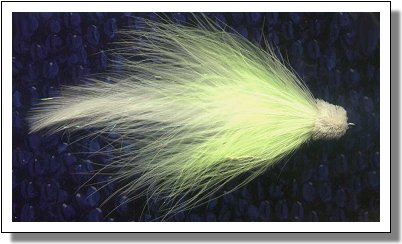
This month's tying table is devoted to the Beastmaster General, one of my favorite larger, more substantial streamer patterns. It has been successful in both salt water and fresh and has accounted for some of the largest fish I've caught within the past few years: stripers, blues, trout, bass (smallmouth and largemouth), as well as many other game fish.
It's a fly with lots of built-in, fish-tempting action that can be fished in a wide variety of ways. You can dead-drift it or skitter it across the surface to force strikes from otherwise reluctant fish. You can pull it under and let it swim back up to the surface in perfect imitation of a wounded baitfish. With an slow-sinking line you can actually hold the fly "in position" to effectively work the most productive depths (many people compare this fly to the deadly Sluggo lure). To fish it deep, simply add a split shot or two to your leader or use a fast-sinking line to fish it deep without hanging up on the bottom. You can fish it fast or fish it slow or somewhere in between--it's almost impossible to fish it wrong--and with skill and practice, so many ways to fish it right.
Tying the Beastmaster General
The instructions given above are for a chartreuse/white Beastmaster General but I tie this up in many colors. Among my other favorites are all-white, all-black, blue/white, yellow/white, yellow/red, red/white, and chartreuse/grizzly. While I tie this fly mostly using wide neck hackle I also tie versions of it using narrower saddles as well. I should also point out that if you tied this fly without the deer hair head and collar and added a collar of mallard in front of the forward marabou hackle you would then have a fly known simply as the Beastmaster.
|
Hook: |
Mustad 34001 or any long shank salt water hook, #1-2/0 |
|
Thread: |
Danville's 3/0 monocord |
|
Tail Wing: |
Two matched pairs of wide white neck hackle |
|
Tail Flash: |
Pearl Gartside's Secret Stuff or silver holographic mylar Flashabou |
|
Rear Hackle: |
Two white blood marabou feathers |
|
Body: |
Pearl Glimmer |
|
Front Hackle: |
Three fluorescent chartreuse blood marabou feathers |
Collar: |
White deer hair points flared |
Head: |
Trimmed white deer hair |
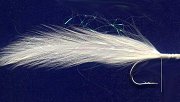 Tie in Tail wing and overlay of flash. Trim excess.
Tie in Tail wing and overlay of flash. Trim excess.
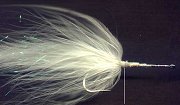 Tie in two white blood marabou feathers and wind them together taking two or three turns around the shank just in front of the tailwing. Trim excess.
Tie in two white blood marabou feathers and wind them together taking two or three turns around the shank just in front of the tailwing. Trim excess.
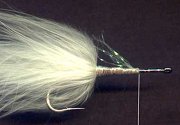 Tie in six-seven strands of Glimmer (you may use another sturdy body material if you don't have Glimmer) and wind forward to form a body. Stop your winding approximately 1/3 the hook shank's length back from the eye of the hook.
Tie in six-seven strands of Glimmer (you may use another sturdy body material if you don't have Glimmer) and wind forward to form a body. Stop your winding approximately 1/3 the hook shank's length back from the eye of the hook.
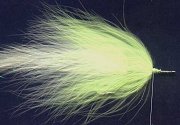 Tie in three chartreuse blood marabou feathers and wind them together taking two or three turns around the shank just in front of the tailwing, being sure to leave plenty of room for your deer hair collar and head. (It's important to remember your head will in general be approximately one-third of the hook shank.) Trim excess.
Tie in three chartreuse blood marabou feathers and wind them together taking two or three turns around the shank just in front of the tailwing, being sure to leave plenty of room for your deer hair collar and head. (It's important to remember your head will in general be approximately one-third of the hook shank.) Trim excess.
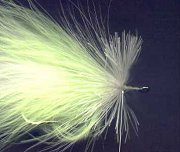 Take a small clump of white deer hair (approx. 3" long), clean it with a brush, and tie it in on the far side of the shank just in front of the marabou hackle, being sure to make the collar points approx. two inches long. Take another clump of the same size, clean this, and tie it in on the near side of of the shank so that these points are about the same length as those on the opposite side. When both sets of hair are tightly secured, push the remaining forward strands of hair back and take a few turns of thread in front of them to keep them in that position (this will now become the rear of your head).
Take a small clump of white deer hair (approx. 3" long), clean it with a brush, and tie it in on the far side of the shank just in front of the marabou hackle, being sure to make the collar points approx. two inches long. Take another clump of the same size, clean this, and tie it in on the near side of of the shank so that these points are about the same length as those on the opposite side. When both sets of hair are tightly secured, push the remaining forward strands of hair back and take a few turns of thread in front of them to keep them in that position (this will now become the rear of your head).
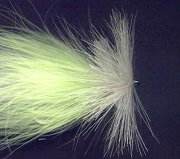 Move your tying thread forward three or four turns in front of the deer hair butts. Now take a larger clump of white deer, clean it with brush or comb--very important!--and tie it in on top of the shank with the butts facing the rear of the fly. With thread pressure move this clump now to the bottom of the shank. Tighten thread with a tap or two of your fingers on the bobbin and then with tight windings to the rear distribute the hairs around the shank of the hook to form the rear portion of the head. Now wind thread forward--again tight turns--until hair is evenly distributed around the hook shank all the way up to the eye of the hook. For more detailed instructions on my unique method of turning hair into hackle, see my book Scratching the Surface.
Move your tying thread forward three or four turns in front of the deer hair butts. Now take a larger clump of white deer, clean it with brush or comb--very important!--and tie it in on top of the shank with the butts facing the rear of the fly. With thread pressure move this clump now to the bottom of the shank. Tighten thread with a tap or two of your fingers on the bobbin and then with tight windings to the rear distribute the hairs around the shank of the hook to form the rear portion of the head. Now wind thread forward--again tight turns--until hair is evenly distributed around the hook shank all the way up to the eye of the hook. For more detailed instructions on my unique method of turning hair into hackle, see my book Scratching the Surface.
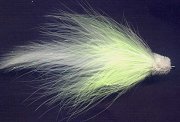 Trim deer hair head to desired shape.
Trim deer hair head to desired shape.






